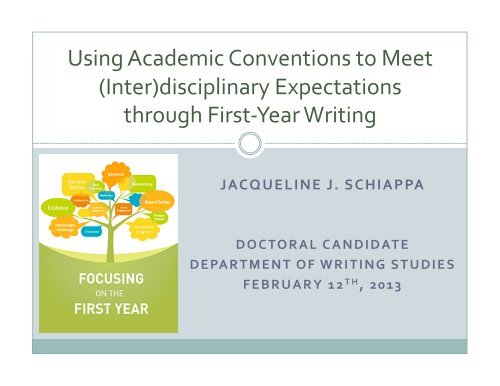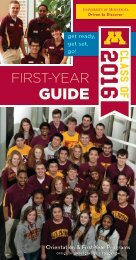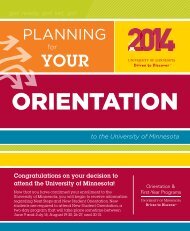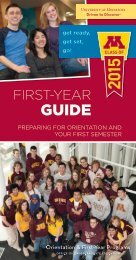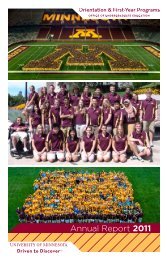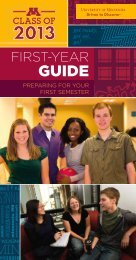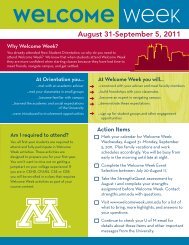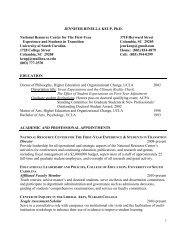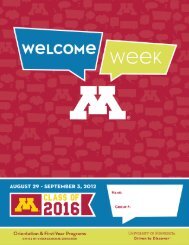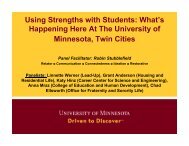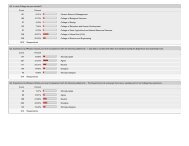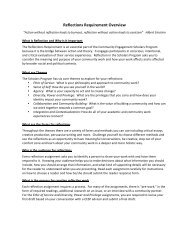Using Academic Conventions to Meet (Inter) - Orientation and First ...
Using Academic Conventions to Meet (Inter) - Orientation and First ...
Using Academic Conventions to Meet (Inter) - Orientation and First ...
- No tags were found...
Create successful ePaper yourself
Turn your PDF publications into a flip-book with our unique Google optimized e-Paper software.
<strong>Using</strong> <strong>Academic</strong> <strong>Conventions</strong> <strong>to</strong> <strong>Meet</strong> (<strong>Inter</strong>)disciplinary Expectations through <strong>First</strong>-‐Year Writing JACQUELINE J. SCHIAPPA DOCTORAL CANDIDATE DEPARTMENT OF WRITING STUDIES FEBRUARY 12 TH , 2013
<strong>Using</strong> <strong>Academic</strong> <strong>Conventions</strong> <strong>to</strong> <strong>Meet</strong> (<strong>Inter</strong>)disciplinary Expectations through <strong>First</strong>-‐Year Writing JACQUELINE J. SCHIAPPA DOCTORAL Courses Other Related CANDIDATE Taught Work DEPARTMENT Fundamentals: <strong>First</strong> OF Year WRITING Writing Program Human STUDIES Communication Advisory Comm. FEBRUARYUniversity Direc<strong>to</strong>r Department of Graduate 12 TH Writing, Affiliations 2013 Studies Advisory Comm. Scientific University Writing Studies Writing <strong>and</strong> Technical Program Presentations Wide Assessor <strong>First</strong> Year Writing Program Writing Associate Blood, Gender, Bodies Women, <strong>and</strong> Science & Sexuality Dept of Writing Studies GS Representative Studies Jacqueline Schiappa SustainableWriting English Studies People, Graduate Sustainable Curriculum Planet .com Feminist Subcommittee Film Studies Environmental Rhe<strong>to</strong>ric Mingus the Dog
Presentation Overview <strong>Conventions</strong> in <strong>Academic</strong> Writing The Pillars: Attention Getter, Literature Review, Preview/Review, Thesis Statement, Conclusion Organization, Citation Strategies for Communicating Writing Assignments <strong>Using</strong> the Assignment Prompt Giving Examples of Every Major Assignment Little Rules, Peer-‐Reviewing Teaching the Reference Manual Addressing ESL/NNES Student Writing Habits Ideas v. Grammar Crutches Student Resources
Session I: “<strong>Using</strong> the Framework for Success” Developing Knowledge of <strong>Conventions</strong> “<strong>Conventions</strong> are the formal rules <strong>and</strong> informal guidelines that define what is considered <strong>to</strong> be correct (or appropriate) <strong>and</strong> incorrect (or inappropriate) in a piece of writing. <strong>Conventions</strong> include the surface features of a text such as mechanics, spelling, <strong>and</strong> attribution of sources, as well as more global concerns such as content, <strong>to</strong>ne, style, organization, <strong>and</strong> evidence.”
Session I: “<strong>Using</strong> The Framework for Success” Rhe<strong>to</strong>rical Knowledge Critical Thinking Writing Processes Knowledge of <strong>Conventions</strong> Ability <strong>to</strong> Compose in Multiple Environments Kirsten Jamsen, Direc<strong>to</strong>r, Center for Writing
<strong>Conventions</strong> in <strong>Academic</strong> Writing Introduction Attention Getter Relevance Preview Thesis Body (A) Literature Review, (B) Analysis/Discussion Organizational framework (Spatial, Chron., Temporal, Topical) Conclusion Transition Review Restate Thesis
Teaching <strong>Conventions</strong> in <strong>Academic</strong> Writing Have students form groups Provide groups with 3 academic article introductions Each article should represent a distinct discipline Ask groups <strong>to</strong> identify the following conventions: Introduction Attention Getter Relevance Preview Thesis
Teaching <strong>Conventions</strong> in <strong>Academic</strong> Writing http://www.scholarsstrategynetwork.org/sites/default/files/skocpol_captrade_report_january_2013_0.pdf
‘Low-‐density lipoprotein binds <strong>to</strong> proprotein convertase subtilisin/kexin type-‐9 (PCSK9) in human plasma <strong>and</strong> inhibits PCSK9-‐mediated LDL recep<strong>to</strong>r degradation’ by Tanja Kosenko, Mia Golder, Geoffrey Leblond, Willy Weng, <strong>and</strong> Thomas A. Lagace. doi:10.1074/jbc.M112.421370
Proprotein convertase subtilisin/kexin type-‐9 (PCSK9) is a secreted protein that binds <strong>to</strong> the epidermal growth fac<strong>to</strong>r-‐like (EGF)-‐A domain of the low-‐density lipoprotein recep<strong>to</strong>r (LDLR) <strong>and</strong> mediates LDLR degradation in liver. Gain-‐of-‐function mutations in PCSK9 are associated with au<strong>to</strong>somal dominant hypercholesterolemia in humans. Size exclusion chroma<strong>to</strong>graphy of human plasma has shown PCSK9 <strong>to</strong> be partly associated with undefined high-‐molecular-‐weight complexes within the LDL-‐size range. We used density gradient centrifugation <strong>to</strong> isolate LDL in plasma pooled from 5 normolipidemic subjects <strong>and</strong> report that >40% of <strong>to</strong>tal PCSK9 was associated with LDL. These data suggest that association of PCSK9 with LDL particles in plasma lowers the ability of PCSK9 <strong>to</strong> bind <strong>to</strong> cell surface LDLRs, thereby blunting PCSK9-‐mediated LDLR degradation.
Teaching <strong>Conventions</strong> in <strong>Academic</strong> Writing
Teaching <strong>Conventions</strong> in <strong>Academic</strong> Writing
Framing the Literature Review as Burke’s Parlor Kenneth Burke -‐ The Philosophy of Literary Form 110-‐111 “Imagine that you enter a parlor. You come late. When you arrive, others have long preceded you, <strong>and</strong> they are engaged in a heated discussion, a discussion <strong>to</strong>o heated for them <strong>to</strong> pause <strong>and</strong> tell you exactly what it is about. In fact, the discussion had already begun long before any of them got there…”
Teaching <strong>Conventions</strong> in <strong>Academic</strong> Writing Introduction Introduction Body Body Conc. Conc. CLOSURE
Value the Assignment Prompt Summer 2010 Writing Associate Experience Focus Groups with <strong>First</strong>-‐Year Writing Instruc<strong>to</strong>rs Discuss everything but the prompt itself <strong>and</strong> its functions Frequent <strong>and</strong> detailed contextualizing Themes in prompts seemingly yielding “good” papers Extensions of in-‐class conversations (contextualized) Included the hard logistics Weren’t overly prescriptive Clear expectations 1-‐2 pages in length Make the value of the prompt clear <strong>to</strong> students
Give Real Examples of Every Major Assignment
Little Rules for Low/Medium-‐Stakes Assignments Can’t begin any sentence with “it” No direct quoting Or, limit <strong>to</strong> 5 words per quote No hanging quotes Use 1-‐2 footnotes Help students discern meaningfulness of content Give students a safe space <strong>to</strong> comment, think, work-‐through
Teach the Reference Manual Activity Suggestion: The Reference Race • Bring diverse source materials • anthology, another anthology, article, newspaper, magazine, website, DVD • Student groups “race” <strong>to</strong> collaborate on an accurate bibliography page with all sources • Build student confidence <strong>and</strong> resourcefulness • Collaborative activity, friendly competition • Effectively teaches students how <strong>to</strong> cite
Make use of existing resources…
The Power of the Peer-‐Review When done well, students enjoy peer-‐reviewing Give ultra-‐specific instructions Use the pillars Ask students <strong>to</strong> identify the conventions in each other’s work Speed-‐dating style peer-‐reviewing Use music cues Opportunity for students <strong>to</strong> become more familiar Get a lot of feedback <strong>to</strong> a lot of students in a short amount of time
Be Aware of [Digital] Practice Changes Unique digital communication modes/spaces necessitate unique writing approaches Use the ubiquity of communication technologies <strong>to</strong> encourage students seeing themselves as already writing Avoid assumptions about student relationships <strong>to</strong> technology Au<strong>to</strong>correct Texting =/= Not-‐Listening Consider multimodal assignments
Vasudevan, L., Schultz, K., & Bateman, J. (2010). Rethinking Composing in a Digital Age: Authoring Literate Identities Through Multimodal S<strong>to</strong>rytelling. Written Communication, 27(4), 442-‐468. Consider multimodal assignments Where “multimodal” s<strong>to</strong>rytelling means “narrating s<strong>to</strong>ries through a range of print, visual, <strong>and</strong> audio modalities.” Encourages students “<strong>to</strong> draw on their knowledge, experiences, <strong>and</strong> passions nurtured in their home communities <strong>to</strong> tell new s<strong>to</strong>ries <strong>and</strong> become more deeply engaged in the academic content of school.” Key point: “The introduction of new composing <strong>to</strong>ols <strong>and</strong> processes provided students with the opportunity <strong>to</strong> take on a broader range of available identities as “successful” students in an academic setting” Ask for conventional components in unconventional form
ESL/NNES Student Writing Habits & Needs Quick Tips Ideas v. Grammar, Syntax Seeking appropriately complex language the “right-‐click syndrome” Cultural differences in student perceptions of claim-making authority Overuse of quotations Space-‐Taking-‐Strategies: Overuse of graphs, images What <strong>and</strong> where are student resources?
Quick Tips Put it in Writing as often as possible Invite taking pictures of the board or activities Avoid explanations that depend on familiarity with popular culture Use synonyms often (frequently, regularly) Smaller Group Activities Use the board
Ideas v. Grammar/Syntax
Ideas v. Grammar/Syntax
Seeking Appropriate Language / The Right-‐Click Syndrome
Student Perceptions of Claim-‐making Authority
Quotation Crutches
Resource: The Writing Center writing.umn.edu The Writing Center can help students think through: • how <strong>to</strong> get started on an assignment • approaches <strong>to</strong> organizing a draft • ways <strong>to</strong> improve clarity • opportunities for revision <strong>and</strong> editing • show strategies for proofreading The Writing Center does not: Nicholson Hall • proofread a paper for a student • write a paper, or tell a student what <strong>to</strong> write • speak for an instruc<strong>to</strong>r • evaluate or guarantee a grade for a paper
Presentation Review <strong>Conventions</strong> in <strong>Academic</strong> Writing The Pillars: Attention Getter, Literature Review, Preview/Review, Thesis Statement, Conclusion Organization, Citation Strategies for Communicating Writing Assignments <strong>Using</strong> the Assignment Prompt Giving Examples of Every Major Assignment Little Rules, Peer-‐Reviewing Teaching the Reference Manual Addressing ESL/NNES Student Writing Habits Ideas v. Grammar Crutches Student Resources
<strong>Using</strong> <strong>Academic</strong> <strong>Conventions</strong> <strong>to</strong> <strong>Meet</strong> (<strong>Inter</strong>)disciplinary Expectations through <strong>First</strong>-‐Year Writing QUESTIONS? COMMENTS? DISCUSSION WELCOMED.


